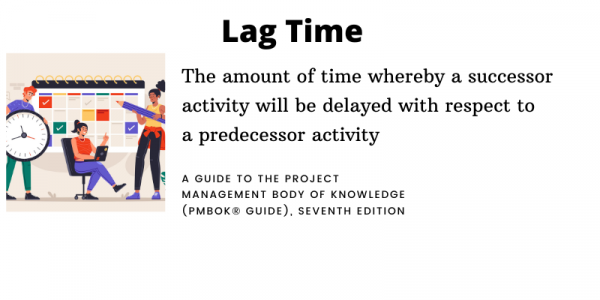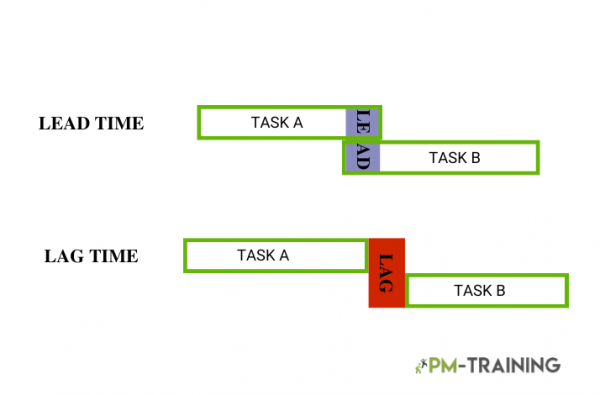Lag time is the amount of time that passes between the start of a project and the time when work begins on that project. This can be caused by a variety of factors, including waiting for approvals, lack of resources, lack of capacity, or poor planning. Lag time can have a major impact on the overall success of a project, as it can lead to delays, cost overruns, and other problems.
Basically, the delay itself is referred to as Lag Time when the first action has been finished but there was a delay with the beginning of the second activity. For example, if you are building a house, you cannot start painting the walls until the drywall has been installed. In this case, the drywall installation would be the predecessor activity and the painting would be the successor activity. The lag time would be the amount of time between when the drywall is installed and when the painting begins.
Lag Time in Practice
When creating a schedule network diagram, you will need to take into account both lead time and lag time.
There are many factors to consider when creating a schedule network diagram.
Lead time and lag time are important to consider when creating a schedule network diagram because they can impact the critical path of a project.

The critical path is the sequence of tasks that must be completed in order for the project to be completed on time. If any of the tasks on the critical path are delayed, the entire project will be delayed.
Keep in mind we can have different tasks dependencies in these are:
- Finish to Start (This is only with a lead time)
- Finish to Finish
- Start to Finish
- Start to Start
To apply lead time and lag time in your schedule network diagram, you will need to consider the order of the tasks, the dependencies between the tasks, and the duration of the tasks. By taking all of these factors into consideration, you can create a strong network diagram
Lead time vs Lag time in project management
In project management, lead and lag time are two measures that are used to schedule and track the progress of a project.
By using software such as MSwe can easily interpret what the indicators say about our schedule. In a schedule network diagram, lead time is represented by arrows, and lag time is represented by dashed lines.
But let’s see what are the main difference between these two:
“Lead time is the amount of time whereby a successor activity can be advanced with respect to a predecessor activity”
Lead time is the length of time that the next task may be advanced such that two tasks can be completed simultaneously.
Lead time can be affected by a number of factors, including the complexity of the project, the availability of resources, and the amount of time that is allocated for the project.
Lead and lag are often used in conjunction with each other. For example, if a task has a lead of two days, that means it can be started two days before its successor. If the task has a lag of two days, that means it can be started two days after its predecessor.
Here’s a picture to illustrate how that difference works.

Lead and Lag example
Lead Time Example
Imagine you are creating a whole new website for a client. As it is going to take 4 months to code it all, it will take you 2 months to create the graphic design.
Instead of waiting until the code is done to start creating the graphics. You start creating them in the 3rd month of the project. So instead of taking 6 in total, it is going to take 5 months by bringing forward the date and leveraging the lead
Lag Time Example
Imagine you are about to build a whole new shed that may take 10 days. You need to wait for 6 days to set the shed foundations properly. As you need to make sure the foundations are well enough you can’t really start working until the foundation is completely set. So instead of taking 10 days to build, you need to add another 6 days to properly set foundations and just there, you can start your work.
Being aware of lag in your project
Lag time is an important concept in project management, and it is something that should be closely monitored during the course of a project.
By understanding lag time and its causes, you can take steps to avoid it and keep your project on track.
Lead and lag can be used to create buffer time between tasks, which can be helpful in managing risks.
Buffer time can also be used to account for unexpected delays or to allow for some flexibility in the schedule
What causes can lag affect your project?
Lag time can cause a number of problems in a project, including missed deadlines, confusion among team members, and a general feeling of frustration.
It is important to understand the causes of lag time so that you can take steps to avoid it and make sure your project is on track.
There are a number of causes of lag time, including:
Lack of clarity about the task
Unclear expectations
Lack of communication
Poor time management
What are the Lead and Lag indicators in project management?
Every project has a number of deliverables, which need to be completed within a certain timeframe. To complete a project on time and within budget, project managers need to constantly monitor both the forward and backward progress of each deliverable.
This is where lead and lag indicators come in.
Just as a driver needs both a rear-view and front-view mirror to see where they have been and where they are going, project managers use lead and lag indicators to track project progress.
Lead Indicators
Lead indicators are those that show progress toward the desired result A lead indicator is a type of predictive metric. For example, a lead indicator will be the number of achievements according to what was expected, as deliverables or tasks accomplished.
Lag Indicators
Lag indicators are those that show the desired result itself. For example, a lag indicator might be the number of change orders issued during a project. If this number is increasing, it could be a sign that the project is veering off course and that corrective action is needed.
By using software such as MSwe can easily interpret what the indicators say about our schedule. In a schedule network diagram, lead time is represented by arrows, and lag time is represented by dashed lines.
FAQs
What is lag Time in Project management?
Lag time is the amount of time between the start of an activity and the completion of that activity. In project management, lag time is often used to schedule activities that cannot be started until another activity has been completed.
What is the most popular Software to manage Lead and Lag tasks?
One of the most powerful tools to understand your Lead and Lag indicator is by far Microsoft Project Management Software. This software will show exactly what really works and what does not.
What are the main differences between Lead and Lag Time in project management?
Lead time is the amount of time it takes to complete a task, while lag time is the amount of time between the completion of one task and the beginning of another.
What is a critical path method?
The critical path is the sequence of tasks that must be completed in order for the project to be completed on time. This path is determined by the dependencies between the tasks and the shortest duration for each task.
